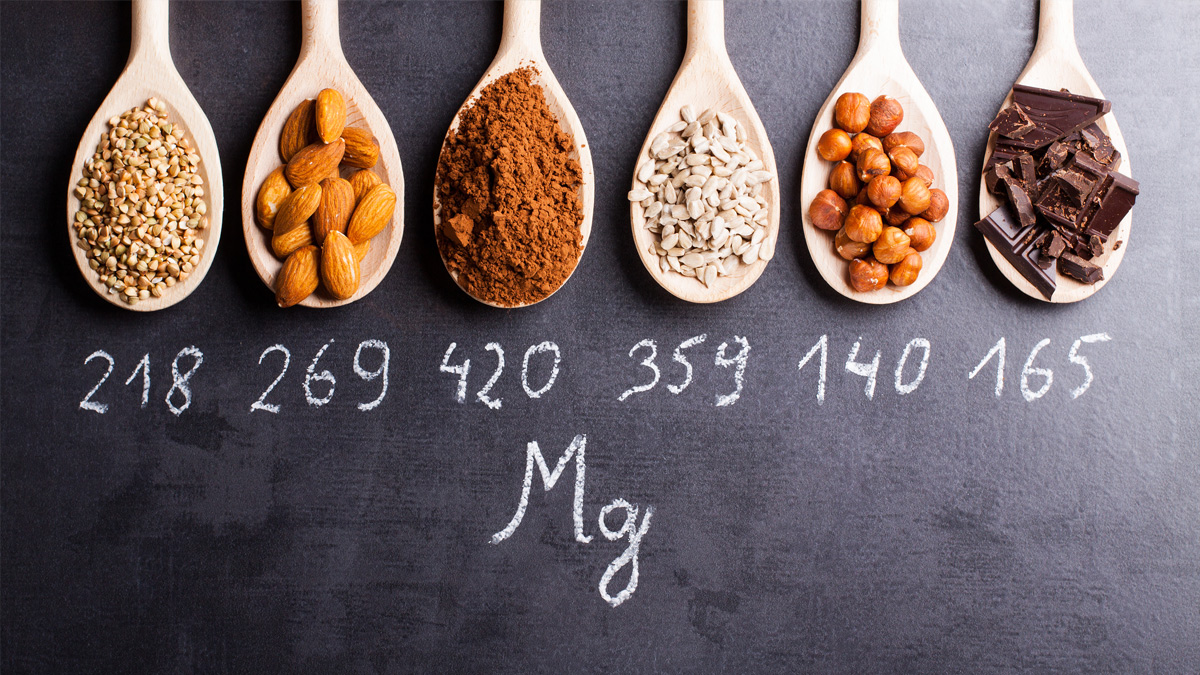Magnesium: the best forms for relieving pain, preventing hypertension and improving memory
There are so many different forms of magnesium … Which should you choose for optimal absorption?

There are indeed many forms of magnesium on the market, some of which are cheaper but which can cause troublesome side-effects (mild diarrhoea) or are less well-absorbed by the body. Others are more expensive but offer greater bioavailability, while others still are specifically formulated for cognitive health. Before we look more closely at these different forms, let’s first examine the potential reasons for taking magnesium supplements.
The body needs magnesium in order to function properly. It is involved in hundreds of different activities such as muscle relaxation, blood coagulation, energy conversion, and blood pressure … Unfortunately, however, in developed countries such as the US, France and the UK, magnesium intake is below the daily amount recommended for more than half the population. What’s more, regular drinkers (1), diabetics (2), women who take oral contraceptives, the over-60s, and people with hypertension have greater requirements for magnesium (3). Some people choose to supplement with magnesium for its therapeutic effects: it reduces the risk of osteoporosis and fractures, lowers blood pressure, may be helpful in relieving migraine and period pain, may improve memory, and helps achieve better glucose control in prediabetics!
In short, magnesium supplementation is worth considering if your diet provides less than 300-420mg a day (4) (which is the case for 1 in 2 of us), or if you suffer from migraines, diabetes, pain, memory problems, osteoporosis or hypertension.
Preferred forms of magnesium
Surprisingly perhaps, few studies have looked at how the various forms of magnesium compare in terms of efficacy. The reason is that absorption of magnesium depends on a great many factors which are not easily reproducible in a scientific setting. But it’s important to know this information as the less absorbable the magnesium is, the less the body will be able to use it and the greater will be its laxative effect! Two factors are significant here: its bioavailability (the ease with which the magnesium enters the bloodstream for use by the body) and its solubility.
Magnesium malate, magnesium chloride, magnesium citrate and magnesium gluconate are the most soluble and bioavailable forms (5). Magnesium orotate, which is usually more expensive, has the additional benefit of carrying some of the magnesium into cells, close to the nucleus and mitochondria, for better mineralisation. More expensive still, L-threonate offers benefits for memory and cognitive function: studies show it produces greater increases in magnesium levels in the brain compared with other forms.
In contrast, magnesium sulfate, magnesium carbonate, magnesium oxide and magnesium hydroxide are best avoided as they are much less bioavailable and have a stronger laxative effect. Inorganic magnesium salts are generally less available than organic salts (6-10) (which also include magnesium glycerophosphate, magnesium pidolate, magnesium taurinate and magnesium arginate).
Note: in the case of deficiency, supplementing with any form of magnesium will have the effect of increasing levels of this mineral in the body. But a supplement that does this more effectively, without triggering attacks of diarrhoea, is obviously preferable. To fully capitalise on magnesium’s therapeutic effects, it’s also advisable to choose the most bioavailable supplements as the higher the level of magnesium ingested, the less effectively it is absorbed.
| Bioavailability | Solubility | Particular characteristic | |
|---|---|---|---|
| Malate | Good | Very good | Contains malic acid, a beneficial chelating agent. |
| Chloride | Good | Very good | Difficult to preserve (very hygroscopic). |
| Citrate | Good | Good | |
| Gluconate | Very good | Good | Low level of elemental magnesium. |
| Carbonate | Bad | Very low | |
| Hydroxide | Bad | Low | |
| Oxide | Bad | Relatively low | Cheapest form. |
| L-Threonate | Good | Good | Increases magnesium levels in the brain. |
| Orotate | Very good | Deposits the minerals inside cells. Optimal mineralisation. |
Other factors to consider when taking magnesium
The form of magnesium, while important, is just one of many factors that influence its absorption. If you take it on a daily basis, it’s important to follow the recommendations below. Essentially, magnesium is absorbed in the small intestine by the passive paracellular pathway (11). Only a minor part is absorbed in the large intestine and colon across cell membranes (12). Absorption begins around an hour after the supplement is ingested and ends after six hours (13). This process is influenced by several limiting or enhancing factors, which may or may not produce unwelcome side effects.
Limiting factors
Intestinal problems. Irritable bowel syndrome, coeliac disease, gut inflammation and all digestive problems reduce magnesium absorption (16-17).
Taking another mineral supplement. Other mineral supplements (zinc, copper, calcium, phosphorus …) reduce magnesium absorption (18-19).
Already having high magnesium levels. Nature is clever: if the body already has enough, its ability to absorb magnesium decreases.
High levels taken in a single dose. Absorption of magnesium is inversely correlated with the dose ingested. In other words, the higher the amount, the lower its ability to be absorbed (20). It is therefore better to spread a daily amount of 400mg of magnesium across three or four doses, choosing a supplement that contains 100mg per tablet (21-22). This is the case for the following four supplements which all offer excellent bioavailability and solubility:
- Magnesium Malate (180mg per tablet).
- Magnesium Orotate (105mg per tablet).
- Magnesium Threonate (163mg per tablet) – more expensive and aimed at cognitive health.
- Optimag (102mg per tablet) – a combination of several forms with higher bioavailability.
Avoid eating spinach or cabbage within a short time of taking magnesium. They contain oxalic acid, a chelating agent which reduces magnesium absorption.
Enhancing factors
Taking the supplement with a meal. Magnesium’s bioavailability is higher when it is taken with a meal, probably because intestinal transit slows down (which extends the time the magnesium is exposed to enterocytes) and also because of the presence of other beneficial foods (23).
Even better if the meal contains protein … Protein increases magnesium’s solubility by preventing the precipitation of calcium-magnesium-phosphate complexes.
… and if it’s rich in prebiotics (fibre)! Fibre nourishes beneficial bifidobacteria which produce short-chain fatty acids (propionate, butyrate, lactate) and reduce the pH of the small intestine, two factors which improve magnesium’s transport towards the bloodstream.
References
- Elisaf M, Bairaktari E, Kalaitzidis R, Siamopoulos K. Hypomagnesemia in alcoholic patients. Alcohol Clin Exp Res. 1998;22:244-246.
- Tosiello L. Hypomagnesemia and diabetes mellitus. A review of clinical implications. Arch Intern Med. 1996;156:1143-1148.
- al-Ghamdi SM, Cameron EC, and Sutton RA. Magnesium deficiency: pathophysiologic and clinical overview. Am J Kidney Dis. 1994;24:737-752.
- Institute of Medicine (U.S.) Dietary reference intakes: for calcium, phosphorus,magnesium, vitamin D, and fluoride. Washington, D.C: National Academy Press; 1997.
- Robert A DiSilvestro, Elizabeth Joseph, Brooke E Starkoff, and Steven T Devor, Magnesium Glycinate Supplementation in Bariatric Surgery Patients and Physically Fit Young Adults, The FASEB Journal, Vol. 27, No. 1_supplement, April 2013
- Lindberg J.S., Zobitz M.M., Poindexter J.R., Pak C.Y. Magnesium bioavailability from magnesium citrate and magnesium oxide. J. Am. Coll. Nutr. 1990;9:48–55.
- Walker A.F., Marakis G., Christie S., Byng M. Mg citrate found more bioavailable than other Mg preparations in a randomised, double-blind study. Magnes. Res. 2003;16:183–191.
- Mühlbauer B., Schwenk M., Coram W.M., et al. Magnesium-L-aspartate-HCl and magnesium-oxide: Bioavailability in healthy volunteers. Eur. J. Clin. Pharmacol. 1991;40:437–438.
- Firoz M., Graber M. Bioavailability of US commercial magnesium preparations. Magnes. Res. 2001;14:257–262.
- Kappeler D., Heimbeck I., Herpich C., et al. Higher bioavailability of magnesium citrate as compared to magnesium oxide shown by evaluation of urinary excretion and serum levels after single-dose administration in a randomized cross-over study. BMC Nutr. 2017;3:7.
- Rude R.K. Magnesium deficiency: A cause of heterogeneous disease in humans. J Bone Miner Res Off J Am Soc Bone Miner Res. 1998;13:749–758.
- De Baaij J.H., Hoenderop J.G., Bindels R.J. Magnesium in man: Implications for health and disease. Physiol. Rev. 2015;95:1–46.
- Hardwick L.L., Jones M.R., Brautbar N., Lee D.B. Site and mechanism of intestinal magnesium absorption. Miner. Electrolyte Metab. 1990;16:174–180
- Saltzman J.R., Russell R.M. The aging gut. Nutritional issues. Gastroenterol. Clin. North Am. 1998;27:309–324.
- Verhas M., De La Gueronniere V., Grognet J.M., Paternot J., et al. Magnesium bioavailability from mineral water. A study in adult men. Eur. J. Clin. Nutr. 2002;56:442.
- Caruso R., Pallone F., Stasi E., Romeo S., Monteleone G. Appropriate nutrient supplementation in celiac disease. Ann. Med. 2013;45:522–531.
- Kruis W., Phuong Nguyen G. Iron deficiency, zinc, magnesium, vitamin deficiencies in Crohn’s disease: Substitute or not? Dig. Dis. 2016;34:105–111
- Clarkson E.M., Warren R.L., McDonald S.J., De Wardener H.E. The effect of a high intake of calcium on magnesium metabolism in normal subjects and patients with chronic renal failure. Clin. Sci. 1967;32:11–18
- Norman D.A., Fordtran J.S., Brinkley L.J., et al. Jejunal andileal adaptation to alterations in dietary calcium: Changes in calcium and magnesium absorption and pathogenetic role of parathyroid hormone and 1, 25-dihydroxy vitamin D. J. Clin. Invest. 1981;67:1599.
- Fine K.D., Santa Ana C.A., Porter J.L., Fordtran J.S. Intestinal absorption of magnesium from food and supplements. J. Clin. Invest. 1991;88:396–402
- Schuette S.A., Ziegler E.E., Nelson S.E., Janghorbani M. Feasibility of using the stable isotope 25Mg to study Mg metabolism in infants. Pediatr. Res. 1990;27:36–40.
- Lönnerdal B. Magnesium nutrition of infants. Magnes. Res. 1995;8:99–105
- Sabatier M., Arnaud M.J., Kastenmayer P., Rytz A., Barclay D.V. Meal effect on magnesium bioavailability from mineral water in healthy women. Am. J. Clin. Nutr. 2002;75:65–71.
Keywords
4 Days
Delivery is prompt and I never saw a…
Delivery is prompt and I never saw a quality problem with the manufacturing. It is not possible to assess efficacy on a personal basis, since too many factors come into play. Efficacy can only be assessed statistically with a sufficient number of cases.
Roger De Backer
5 Days
I collaborates with the Supersmart…
I collaborates with the Supersmart more than 10 years. Every thing is going good. Quality of the things is good. Delivery comes in time. Five stars definitely !!!
Oleksiy
5 Days
All good
Simple, frictionless site, easy ordering, good delivery updates and execution.
Chris Robbins
7 Days
I feel better
I feel better
Peter Ammann
8 Days
Prompt delivery
Prompt delivery
JAKUB Radisch
9 Days
My new go-to for top quality supplements!
I am buying more and more of my supplements from this superb, high quality company. Cannot recommend it enough. Plus, excellent customer service with a quick, helpful team and speedy deliveries. Highly recommend Supersmart!
Cecilie H.
12 Days
SUPERSMART WHAT ELSE👍
SUPERSMART WHAT ELSE👍
DIEDERLE Christophe
15 Days
Excellent quality products with…
Excellent quality products with innovative formulas, as someone who has been suffering with acid reflux, these supplements have been lifesavers.
Oriana Moniz
15 Days
high quality supplement!
high quality supplement!
GALANT
16 Days
Good service prompt delivery
Good service prompt delivery
Mrs Marcella Reeves
21 Days
I like your clear explanation
I like your clear explanation. And how to make a choice of products for a specific health problem
Ingrid
27 Days
Great product and it arrives quickly.
Great product and it arrives quickly.
SOMMARIVA Gianni
28 Days
Excellent products and fast service.
Excellent products and fast service. What do we need more?
Margarida
32 Days
The variety of products is amazing
The variety of products is amazing, the offers are good and the sending is very fast. I just miss having a bit more of guidance about combinations, possible interactions, etc.
Maria Angeles Verdu
34 Days
It was quick
It was quick.
Timo Antero





